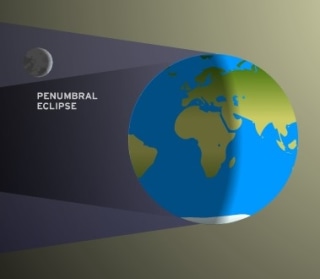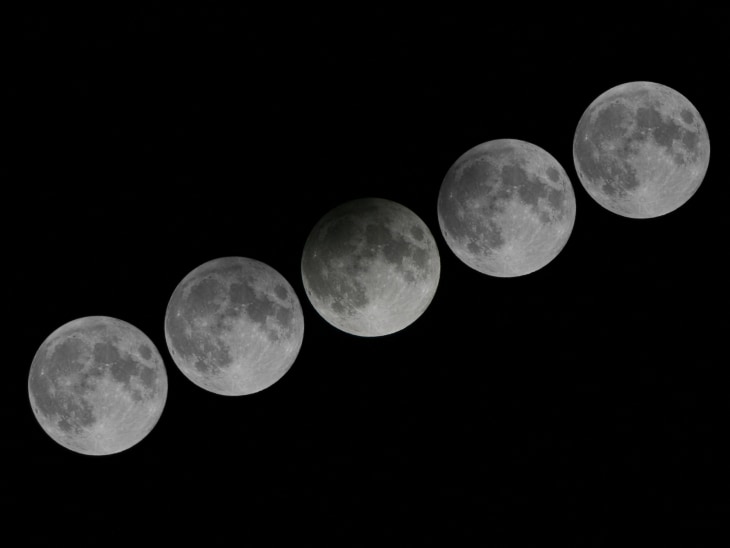Lunar eclipse! Comet! Meteors! See this weekend's sky highlights online
Hong Kong Observatory
A multiple-exposure image shows a penumbral lunar eclipse over Hong Kong.
Little things do add up: As separate events, a penumbral lunar eclipse, a comet-viewing opportunity and the Orionid meteor shower aren't exactly extravaganzas — but when you put those three phenomena together, the combination verges on must-see astronomy.
The moon goes (slightly) dimPutting them together is exactly what the Slooh virtual observatoryis doing this weekend, starting at 5:45 p.m. ET Friday with pictures of the moon.
The moon goes (slightly) dim
Putting them together is exactly what the Slooh virtual observatoryis doing this weekend, starting at 5:45 p.m. ET Friday with pictures of the moon.

NBC News file
During a penumbral lunar eclipse, the moon passes through the lighter part of Earth's shadow, known as the penumbra.
Slooh will be broadcasting imagery from its remote-controlled Half Meter Telescope in the Canary Islands. The show really gets going at 7:30 p.m. ET, when Slooh's Paul Cox and astronomer Bob Berman begin their live commentary.
It helps to have the commentary, because Friday's eclipse is reallysubtle. During a penumbral eclipse, the moon passes only through Earth's faint outer shadow, called the penumbra. ThisFlash interactive graphic shows you how it works.
"Although a penumbral lunar eclipse might go unnoticed by someone casually glancing at the moon, we will be able to observe the gradual shading of the moon in the live images Slooh will broadcast throughout the eclipse," Cox said in a news release. "The shading becomes far more apparent when viewed as a time-lapse [video], and we'll show viewers that during the live segment of the show."
The eclipse peaks at 7:50 p.m. ET, and brightens up into your typical full moon — known as the "Hunter's Moon" this month — about 45 minutes after that. Slooh plans to end its live-streaming moon views at 9:55 p.m. ET.
Watch Slooh's coverage of the lunar eclipse starting at 5:45 p.m. ET Friday.
Comet ISON and Mars
Just a few hours later, starting at 1:30 a.m. ET Saturday, Slooh willbroadcast images of Comet ISON, a visitor from the solar system's hinterlands that skywatchers hope will turn into the "comet of the century." It's still hard to predict just how bright ISON will get, but this week, scientists at the Space Telescope Science Institute said it's looking as if the comet is holding together for a crucial swing around the sun next month.
Just a few hours later, starting at 1:30 a.m. ET Saturday, Slooh willbroadcast images of Comet ISON, a visitor from the solar system's hinterlands that skywatchers hope will turn into the "comet of the century." It's still hard to predict just how bright ISON will get, but this week, scientists at the Space Telescope Science Institute said it's looking as if the comet is holding together for a crucial swing around the sun next month.
If ISON survives that encounter, it should put on a good show in early December. Saturday's viewing opportunity isn't nearly as spectacular. The comet is still to faint to see with the naked eye; however, it's well within the capability of Slooh's telescopes on the Canary Islands — or backyard telescopes, for that matter. ISON is shining in the night sky just 1 degree to the left of Mars, about a thumb's width away, as Colorado Mountain College's Jimmy Westlake explains.
Slooh's Half Meter Telescope will be trained on ISON, while its T2 Wide Field Telescope will show Mars and ISON in the same field of view. Cox will provide expert commentary and take questions via Twitter (just use the hashtag #ISON). He'll be joined by Christina Feliciano, a Slooh member who's heading up an ISON observing team.
Watch Slooh's coverage of Comet ISON starting at 1:30 a.m. ET Saturday.
Observing the Orionids
This weekend is also prime time for the Orionid meteor shower, which flares up every October when Earth passes through the stream of cosmic grit left behind by Halley's Comet. This isn't the best year for the Orionids, due to the glare of that just-past-full moon, but there's still a chance of seeing shooting stars. The best views are expected between midnight and dawn on Sunday and Monday.
This weekend is also prime time for the Orionid meteor shower, which flares up every October when Earth passes through the stream of cosmic grit left behind by Halley's Comet. This isn't the best year for the Orionids, due to the glare of that just-past-full moon, but there's still a chance of seeing shooting stars. The best views are expected between midnight and dawn on Sunday and Monday.
The best way to experience any meteor shower is to get outside and see it for yourself. You'll want to get away from city lights, find a place where there's a wide-angle perspective on the sky, get comfortable and give your eyes time to adjust to the darkness.Check out these additional suggestions for making the most of the meteors.
If you're clouded out, or not inclined to shiver in the October chill, you can huddle around a computer screen and watch Slooh's coverage of the Orionids. The video starts up around 5 p.m. ET Sunday, and Slooh President Patrick Paolucci says there'll be live commentary at 8 p.m. ET. The audience can send in Twitter questions for Cox and Berman using the hashtag #Orionid.
"Slooh has mixed feelings about 'hyping' relatively minor showers," Paolucci told NBC News in an email. He said the only meteor showers that produce a reliably good show for casual observers are the Perseids in August, the Geminids in December, and occasionally the Leonids in November.
"Nonetheless, of the dozens of minor showers, the Orionids rank among the best," Paolucci said. "Moreover, having the distinguished pedigree of being progeny of the most famous comet in history entitles them to be showcased. Slooh hopes to capture enough to make this 15-minute real-time program worthwhile."
Watch Slooh's show about the Orionids at 5 p.m. ET Sunday.

Tidak ada komentar:
Posting Komentar